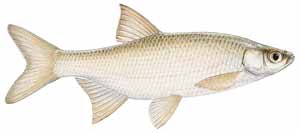Golden Shiner (Notemigonus crysoleucas)
- Description
- Both Notemigonus and crysoleucas are Greek, meaning "angled back" and "golden white" (a reference to the fish's color). The golden shiner is a deep-bodied minnow. There are 7-9 branched rays in the dorsal fin, and 8-19 branches rays in the anal fin. The mouth is small and upturned. The lateral line has a strong downward curve. The back is olive green, with a darker stripe along the midline. The sides range in color from silver to gold. In Texas, golden shiners in excess of 8 inches and weighing 0.25 pounds have been reported.
- Life History
- Spawning begins in the spring when water temperatures reach about 70°F and ceases when temperatures exceed 80°F. Sometimes spawning resumes in late summer if temperatures drop below 80°F. No nest is prepared. Adhesive eggs are scattered over algae or submerged vegetation and hatch in approximately 4 days under good conditions. Golden shiners are omnivorous. Plant material makes up about half the diet; the other half is animal material such as crustaceans, insects, and snails.
- Habitat
- Typically, golden shiners prefer water with little to no current.
- Distribution
- The golden shiner ranges over most of eastern North America. In the east, the species if found from Nova Scotia south to Florida. In the central plains it becomes very rare, especially west of a line extending from central Texas through central Montana. However, the species is well represented in parts of Arizona and California. In Texas, the golden shiner is nearly ubiquitous, probably as a result of bait releases. It is believed to have been native only to east Texas streams.
- Other
- Often used as a bait fish
